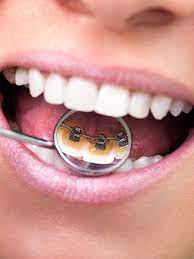Lingual Braces
 We Happy Smile Dental Clinic provide the best treatment for Lingual braces cost in India are very reasonable. Misaligned teeth mar your smile and give you a serious aesthetic and social disadvantage. In addition, it is also difficult to clean crooked teeth, and it creates problems during speaking and eating. As a result, misaligned teeth are at a greater risk of developing teeth cavities and periodontal problems. For over a century, metallic dental braces have been a popular device to improve one’s smile and oral health by straightening crooked and misaligned teeth.
We Happy Smile Dental Clinic provide the best treatment for Lingual braces cost in India are very reasonable. Misaligned teeth mar your smile and give you a serious aesthetic and social disadvantage. In addition, it is also difficult to clean crooked teeth, and it creates problems during speaking and eating. As a result, misaligned teeth are at a greater risk of developing teeth cavities and periodontal problems. For over a century, metallic dental braces have been a popular device to improve one’s smile and oral health by straightening crooked and misaligned teeth.
Over the decades, driven by esthetic requirements and human ingenuity, the metallic dental braces have evolved from ugly metal-mouth forms to sleek current forms. Although these braces have improved greatly in form and function, they still possess some serious disadvantages, such as poor esthetics due to their metallic appearance.
For conventional wire braces, the archwires run outside the teeth and hold the brackets also outside the teeth. Thus, the archwire and the brackets show up when the person speaks or smiles. To overcome this problem, braces were designed in such a way that they were attached to the lingual (towards the tongue) surface of the teeth and they became invisible. These types of braces are known as lingual braces.
Lingual braces are fixed orthodontic appliances that are attached to the teeth just like conventional braces. However, the only difference is that they are attached to the inner surface of the teeth. The only things visible are the thin dental bands that go around the individual teeth. Thus cosmetically, lingual braces are far superior to the conventional wire braces
Application of lingual braces
Just like the conventional (front) braces, the process involves the following steps:
- Removal of teeth to create space: Sometimes, one or two teeth need to be removed from one or both jaws to create room for the alignment of the remaining teeth.
- Impression taking: Your orthodontist takes impressions of your teeth using a special paste that will harden. He or she will ask you to bite on it and hold the mouth closed till it solidifies. This impression is then used to prepare study models, which in addition to x-rays, are used for preparing a customized treatment plan.
- Brackets: Next, the brackets are attached to the inner surface of all the teeth. An archwire made from stainless steel or titanium alloys passes through specially created slots in the braces and ends at the bans which are attached to the molar teeth in both jaws. The wire is attached to the teeth with the help of ties or ligature, which are available in different colours.
- Adjustment: The dentist adjusts the archwire to apply controlled force on the teeth, and makes sure none of the structure causes any irritation to the tongue or palate. That completes the initial set up.
After braces
Just like for conventional braces, adjustments must be made monthly, and the complete alignment may take two-three years when using lingual braces.
The exact period will depend on the initial misalignment, crowding of the teeth or bite problems. Again, retainers must be used for about six months after the braces are removed.
Just like other orthodontic appliances, special attention must be paid to oral hygiene so that tooth decay or gingivitis do not develop. This involves:
- Brushing: Regular brushing with a soft brush at least twice a day and flossing or oral irrigation.
- Flossing: Flossing daily (floss threader can also be used) or an interproximal brush (if space between the teeth is present) to remove plaque and food debris between the teeth.
- Fluoride Therapy: Fluoride rinses will help strengthen the teeth. Above all this, six-monthly inspections and cleanings are recommended.
The downside
Not all orthodontists offer lingual braces because special training and technical expertise are needed. Space between the teeth and the tongue or palate may be limited, and the braces may initially cause irritation. The archwire and the brackets are customs made due to these complications, and hence, lingual braces cost somewhat more.
Types of lingual braces
Lingual braces and wires are made by many different companies. Some of them are Incognito (3M), ALIAS (Ormco), Innovation L (Dentsply/GAC International), eBrace (Riton BioMaterials), Stb Light (Ormco) and Harmony (American Orthodontics).
Incognito
Incognito lingual brackets and wires are made by 3M in Germany. These appliances were initially designed by Dirk Wiechmann. He published his results in 2003 in the American Journal of Orthodontics and Dentofacial Orthopedics, where he reported testing these appliances for 18 months on 600 bonded arches on patients in his private practice. The company uses CAD/CAM technology to combine bracket fabrication and bracket positioning which is done on computer models. The wires and brackets are customized to each patient’s anatomy of the lingual tooth surface.
The bases of these brackets are bigger than other brackets produced by different companies, however, these appliances have thinner bracket base and use less bonding material than other brackets. This may be seen as an advantage by some due to the Lingual braces low profile of brackets which may cause less irritation to the tongue of patients, but this does lead to creating 1st order bends in the wires to compensate for the low profile of these brackets.
A study done in Germany in 2005 compared the pre-adjusted lingual brackets (Ormco) to customized lingual brackets (Incognito) on a group of 40 German-speaking women. The results stated that customized brackets in the study induced significantly fewer cases of tongue space restriction, pressure sores, reddening or lesions to the tongue in the long term than the pre-fabricated brackets. Even though the results favour the Incognito appliance, it should be kept in mind that this is a subjective opinion of people which may confound the results.
Lingual Braces Cost in India is very affordable to you.
Read more about braces:











